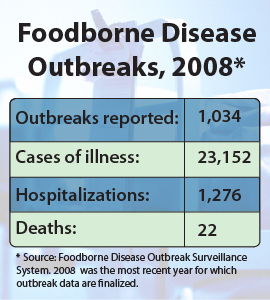Foodborne Disease Outbreaks Are Deadly Serious – What You Can Do to Avoid Them
Many outbreaks result from food being contaminated when it is being prepared or served by a food worker with unwashed or improperly washed hands. Scientific evidence shows that preventing illness begins with the basics. Wash your hands thoroughly, with soap, before and after handling food. It can prevent illness and even death.
 Germs such as norovirus, Salmonella, and E. coli cause thousands of illnesses and deaths in the United States each year. Hospitalizations resulting from foodborne disease outbreaks have increased in recent years but can be prevented if people follow proper food handling practices.
Germs such as norovirus, Salmonella, and E. coli cause thousands of illnesses and deaths in the United States each year. Hospitalizations resulting from foodborne disease outbreaks have increased in recent years but can be prevented if people follow proper food handling practices.
During 2008 alone, 1,034 foodborne disease outbreaks were reported. More than 23,000 people got sick during these outbreaks, and 22 people died. Almost half of the outbreaks had a single cause or food source. Norovirus was the most common cause, accounting for nearly half of the outbreaks and illnesses. The top foods that caused the outbreaks were poultry (15%), beef (14%), and fish (14%).
More than 1,200 people were hospitalized because of foodborne outbreaks in 2008. That’s 6% of all people who got sick during the outbreaks – a high percentage compared with the 4% average reported for 2003 through 2007. In fact, this was the largest number of hospitalizations for foodborne illness reported since the outbreak surveillance system began in 1973. The top three causes of hospitalization in 2008 were:
- Salmonella (62%)
- Shiga toxin-producing E. coli (17%)
- Norovirus (7%)
Ninety percent of illnesses in botulism outbreaks resulted in hospitalization as well as 76% of illnesses in Listeria outbreaks.
Twenty-two deaths were attributed to foodborne disease outbreaks. Salmonella was responsible for the most deaths (13), followed by Listeria and E. coli (3 each).
What You Can Do
- You can keep you and your family safer by remembering to:
- Clean. Wash hands, cutting boards, utensils, and countertops.
- Separate. Keep raw meat, poultry, and seafood separate from ready-to-eat foods.
- Cook. Use a food thermometer to ensure that foods are cooked to a safe internal temperature:
- 145°F for whole meats (allowing the meat to rest for 3 minutes before carving or consuming),
- 160°F for ground meats, and
- 165°F for all poultry.
- Chill. Keep your refrigerator below 40°F, and refrigerate food that will spoil.
- Report suspected illness from food to your local health department.
- Don't prepare food for others if you have diarrhea or have been vomiting.
- Be especially careful when preparing food for children, pregnant women, those in poor health, and older adults.

More Information
- CDC Foodborne Disease Outbreak Surveillance
- Centers for Disease Control and Prevention. Surveillance for Foodborne Disease Outbreaks – United States, 2008. MMWR 2011;60(35);1197-1202.
- Foodborne Outbreak Online Database (FOOD)
- Food Safety and Inspection Service (FSIS) Performance Standards for Salmonella and Campylobacter (July 1, 2011) [PDF - 425 KB]
- CDC Food Safety
- CDC Food Safety: Prevention and Education
- FoodSafety.gov
CDC works 24/7 saving lives and protecting people from health threats to have a more secure nation. A US federal agency, CDC helps make the healthy choice the easy choice by putting science and prevention into action. CDC works to help people live longer, healthier and more productive lives.
Get email updates
To receive email updates about this page, enter your email address:
Contact Us:
- Centers for Disease Control and Prevention
1600 Clifton Rd
Atlanta, GA 30333 - 800-CDC-INFO
(800-232-4636)
TTY: (888) 232-6348 - cdcinfo@cdc.gov



